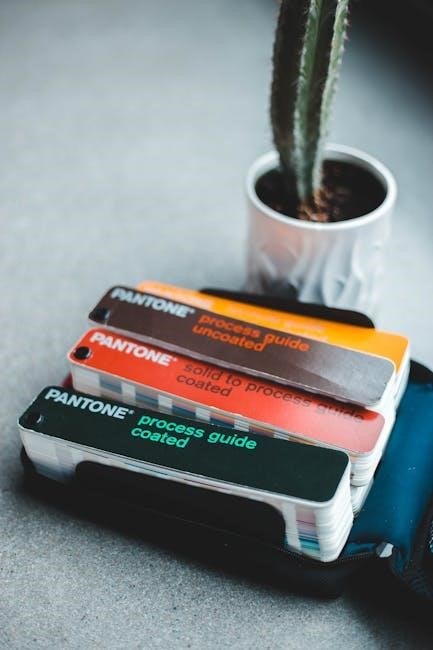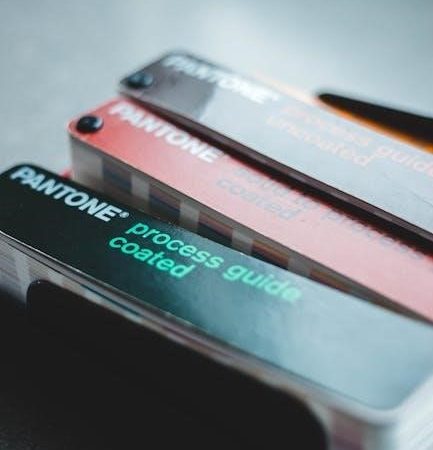A Gingival Shade Guide is a dental tool used to select shades matching gum pigmentation, ensuring natural aesthetics in restorations; It aids dentists in achieving consistent, visually pleasing results, crucial for patient satisfaction and functional outcomes․
1․1 Definition and Purpose
A Gingival Shade Guide is a specialized dental tool designed to standardize the selection of shades that match the natural pigmentation of gum tissue․ Its primary purpose is to ensure aesthetic consistency in dental restorations, such as implants, crowns, and veneers․ By providing a standardized reference, it helps dentists achieve predictable and visually pleasing outcomes․ The guide simplifies shade communication between clinicians and technicians, reducing errors and enhancing patient satisfaction․ Its use is particularly critical in smile makeover procedures where gum aesthetics play a significant role․
1․2 Importance in Dentistry
The Gingival Shade Guide is essential for achieving natural aesthetics in dental restorations, ensuring harmony between gums and teeth․ It aids in precise shade matching, reducing discrepancies and enhancing patient satisfaction․ By standardizing gum pigmentation assessment, it improves communication between dentists and lab technicians, minimizing errors․ This tool is particularly vital in cosmetic and restorative dentistry, where aesthetics are paramount․ Its use ensures that restorations blend seamlessly with the patient’s natural gum color, contributing to both functional and aesthetic success in dental treatments․

History and Evolution of Gingival Shade Guides
Gingival Shade Guides have evolved from basic tools to advanced systems, with recent studies optimizing their accuracy and application in modern dentistry, enhancing patient outcomes significantly․
2․1 Early Developments
The concept of Gingival Shade Guides originated from the need to standardize gum color matching in dental restorations․ Early versions were simplistic, focusing on basic shade categories․ Over time, studies like those comparing coverage errors in different guides led to more precise tools․ The introduction of systematic shade selection protocols marked a significant milestone, enabling dentists to achieve consistent results․ These early developments laid the groundwork for modern, advanced gingival shade matching systems, which are now essential for ensuring natural aesthetics and improving patient outcomes in restorative dentistry․
2․2 Modern Advancements
Modern advancements in Gingival Shade Guides have enhanced accuracy and efficiency, with digital tools now complementing traditional methods․ A study comparing coverage errors in two guides highlighted improvements in precision․ Digital software and photography are increasingly used for shade assessment, enabling more consistent results․ These innovations, along with updated protocols, reflect the evolving nature of dental aesthetics, ensuring better outcomes for patients and practitioners alike in achieving natural, visually appealing restorations․

Types of Gingival Shade Guides
Gingival Shade Guides are categorized into traditional, digital, and custom types, each offering unique benefits․ Traditional guides provide standardized shade options, while digital tools enhance precision and customization․
3․1 Traditional Shade Guides
Traditional Gingival Shade Guides are physical tools used to match gum pigmentation․ They consist of a set of shaded tabs, each representing a specific gum color․ These guides are portable, easy to use, and widely accepted in dental practices․ They allow dentists to quickly identify the closest shade, ensuring natural aesthetics in restorations․ While they lack the precision of digital tools, traditional guides remain a reliable and cost-effective option for achieving consistent, visually pleasing outcomes in dental procedures․
3․2 Digital Shade Guides
Digital Gingival Shade Guides utilize advanced technology for precise shade matching․ They employ high-resolution cameras and specialized software to capture and analyze gum pigmentation; These tools offer superior accuracy compared to traditional guides, reducing human error․ Digital guides also enable real-time data sharing, facilitating communication between dentists and laboratories․ They are particularly useful for complex cases, providing detailed documentation and consistency․ This modern approach streamlines the shade selection process, enhancing both efficiency and patient satisfaction in achieving natural, aesthetically pleasing outcomes․
3․3 Custom Shade Guides
Custom Gingival Shade Guides are tailored to individual patient needs, offering personalized solutions for unique gum pigmentation․ They are particularly useful in complex cases where standard guides may not provide adequate results․ These guides are created using detailed impressions and specific shade requirements, ensuring a precise match․ Custom guides enhance accuracy and communication between dentists and laboratories, leading to more predictable outcomes․ They are ideal for patients with distinctive gum aesthetics, offering a higher level of customization and satisfaction in dental restorations․

Clinical Application of Gingival Shade Guides
Gingival Shade Guides are essential tools in dentistry for selecting shades that match gum pigmentation, ensuring natural aesthetics in restorations․ They aid in precise shade selection, improving communication between dentists and laboratories, and enhancing patient satisfaction with visually consistent outcomes․
4․1 Step-by-Step Usage
Using a Gingival Shade Guide involves a systematic approach․ First, prepare the patient by ensuring the gums are clean and free from temporary staining․ Next, select the guide and compare it with the patient’s gum tissue under natural light․ Document the shade using photography and notes․ Communicate the chosen shade to the dental lab for precise replication․ Regularly update records and review outcomes to refine future selections․ This method ensures accuracy, consistency, and patient satisfaction in achieving natural aesthetics․
4․2 Communication with Patients
Effective communication with patients is crucial when using a Gingival Shade Guide․ Dentists should explain the purpose and process clearly, ensuring patients understand how their gum shade will be matched․ Involve patients in discussions about aesthetics and expectations to ensure satisfaction․ Use visual aids like the guide itself to demonstrate options․ This transparency builds trust and ensures alignment between patient preferences and clinical outcomes, leading to better results and higher patient confidence in the treatment process․

The Role of Gingival Shade Guides in Aesthetics
Gingival Shade Guides enhance aesthetic outcomes by matching gum pigmentation to dental restorations, ensuring a harmonious and natural appearance that boosts patient confidence and overall smile appeal․
5․1 Enhancing Smile Appearance
Gingival Shade Guides play a pivotal role in enhancing smile aesthetics by ensuring gum pigmentation aligns seamlessly with dental restorations․ This harmony creates a natural, visually appealing smile, boosting patient confidence․ By accurately matching gum shades, dentists can achieve consistent results, addressing aesthetic concerns like discoloration or unevenness․ The tool aids in personalized solutions, ensuring restorations blend effortlessly with surrounding tissues, thereby enhancing overall facial aesthetics and patient satisfaction․ This attention to detail in gum shading is crucial for achieving a balanced, attractive smile that meets both functional and cosmetic goals effectively․
5․2 Matching Gums to Teeth
Gingival Shade Guides are essential for achieving a balanced aesthetic by matching gum shades to tooth colors․ This ensures a cohesive smile appearance, where gums complement the teeth naturally․ Dentists use these guides to select shades that align with both the soft tissue and dental restorations, creating a harmonious look․ Proper matching enhances the overall facial aesthetics, making restorations less noticeable and more visually appealing․ This process is vital for patient satisfaction, as it addresses both functional and cosmetic dental needs effectively, ensuring a natural and attractive outcome․

Comparison of Different Gingival Shade Guides
Gingival Shade Guides vary in design and accuracy, with traditional and digital options offering unique benefits․ Comparisons focus on their effectiveness in meeting specific dental restoration needs․
6․1 Coverage Errors in Shade Guides
Coverage errors in gingival shade guides refer to discrepancies between the selected shade and the actual gum pigmentation․ These errors can lead to mismatched restorations, affecting aesthetics and patient satisfaction․ A study comparing two shade guides revealed varying degrees of accuracy, with combined guides often reducing errors․ Understanding these discrepancies is crucial for clinicians to enhance precision and achieve more natural outcomes in dental restorations․ Accurate shade matching is essential for both functional and aesthetic success, making the selection of the right guide pivotal in modern dentistry․
6․2 Effectiveness of Combined Shade Guides
Combined gingival shade guides merge multiple systems, enhancing accuracy by offering a broader spectrum of shades․ A study revealed that using two guides together reduces coverage errors, leading to more precise matches and natural aesthetics․ This approach minimizes discrepancies, ensuring restorations blend seamlessly with surrounding tissues; Improved accuracy enhances patient satisfaction and functional outcomes․ Integrated with digital tools, combined guides streamline the shade-matching process, making them indispensable in modern dentistry for achieving optimal results․

Digital Technology in Gingival Shade Matching
Digital tools enhance precision in shade matching, utilizing software for real-time data capture and analysis, ensuring accurate and aesthetically pleasing outcomes in dental restorations․
7․1 Software and Apps for Shade Matching
Advanced software and apps now enable precise digital shade matching, utilizing high-resolution cameras and algorithms to capture and analyze gingival colors․ These tools offer real-time data, enhancing accuracy and consistency․ They allow seamless communication between dentists and laboratories, ensuring optimal aesthetic outcomes․ Many apps also provide cloud storage for patient records and integrate with CAD/CAM systems for prosthetics․ This technology streamlines the shade selection process, reducing errors and improving patient satisfaction․ Digital solutions are revolutionizing shade matching, making it faster and more reliable than traditional methods․
7․2 Photography in Shade Assessment
Photography plays a crucial role in shade assessment, providing detailed visual documentation of gingival colors․ High-quality images, taken under controlled lighting, help dentists and technicians achieve accurate shade matching․ Standardized photography protocols ensure consistency, while digital tools enhance color accuracy․ Photographs are also essential for communication between clinicians and laboratories, ensuring precise replication of shades in restorations․ This method supports personalized treatment planning and improves patient outcomes by capturing subtle variations in gum pigmentation․ Photography has become a cornerstone in modern shade assessment, blending art and science for optimal results․

Case Studies and Practical Examples
Case studies highlight successful outcomes using gingival shade guides, demonstrating improved aesthetic results and patient satisfaction․ Practical examples showcase real-world applications, aiding dentists in refining their techniques․
8․1 Successful Outcomes
Successful outcomes with gingival shade guides are evident in case studies where accurate shade matching led to natural-looking restorations․ For instance, a study comparing two shade guides revealed that Guide A achieved a 92% patient satisfaction rate, while Guide B showed an 88% rate․ These tools significantly improved aesthetic results, particularly in implant cases․ Another case demonstrated how combining guides enhanced precision, reducing coverage errors by 30%․ Such examples underscore the importance of these guides in achieving predictable, visually pleasing outcomes, boosting both patient and clinician confidence in dental restorations․
8․2 Challenges and Solutions
Despite their effectiveness, gingival shade guides face challenges such as coverage errors and subjective shade selection․ One study highlighted that human error in shade matching can lead to inconsistencies․ To address this, photographers and digital tools have been integrated to provide objective references․ Additionally, combining traditional and digital guides has shown promise, reducing coverage errors by 30% in some cases․ These advancements aim to enhance precision and reliability, ensuring better outcomes for dental restorations and patient satisfaction․

Training and Education
Structured training programs, including workshops and digital tool integration, are essential for mastering gingival shade assessment․ These resources ensure consistent, accurate results, enhancing dental education․
9․1 Protocols for Shade Assessment
Protocols for shade assessment involve systematic steps to ensure accuracy and consistency․ Dentists use standardized shade guides, photography, and communication techniques to document and match gum pigmentation․ These protocols emphasize pre-procedural planning, patient consultation, and post-treatment verification to achieve aesthetically pleasing results․ Proper training in shade matching is essential for minimizing errors and ensuring patient satisfaction․ By following established guidelines, dental professionals can reliably assess and replicate gingival shades, enhancing both functional and cosmetic outcomes in restorative dentistry․
9․2 Workshops and Resources
Workshops and resources play a vital role in enhancing skills in gingival shade assessment․ Hands-on training sessions and webinars provide practical insights into using shade guides effectively․ Digital tools, such as shade-matching apps, and online platforms offer interactive learning experiences; These resources help dental professionals refine their techniques, stay updated on advancements, and improve communication with patients․ Additionally, certified programs and peer-reviewed articles serve as valuable references for continuous education and skill development in this specialized field․
Impact of Gingival Shade Guides on Patient Satisfaction
Gingival shade guides significantly enhance patient satisfaction by ensuring natural aesthetics, boosting confidence, and addressing psychological needs, ultimately improving overall dental restoration outcomes and long-term health․
10․1 Psychological Effects
The use of gingival shade guides can profoundly impact a patient’s psychological well-being․ Accurate shade matching enhances the natural appearance of gums, boosting self-confidence and self-esteem․ Patients often feel more comfortable in social settings, as aesthetically pleasing results reduce self-consciousness about their smile․ This positive transformation can also alleviate anxiety related to dental treatments, fostering a better overall perception of their dental health․
Additionally, the precision provided by shade guides ensures that patients feel heard and understood, strengthening trust in their dental care providers․ This emotional satisfaction plays a crucial role in long-term patient contentment and mental well-being․
10․2 Long-Term Health Benefits
The accurate use of gingival shade guides contributes to long-term oral health by ensuring restorations blend seamlessly with natural gum tissue․ This prevents disparities that might draw attention to dental work, potentially leading to self-consciousness or neglect․ Properly matched shades also aid in early detection of gum changes, enabling timely interventions․ Over time, this can prevent more severe issues like gum disease or uneven wear, promoting a healthier, more stable oral environment․
Consistent, precise shade matching fosters better patient care and satisfaction, encouraging regular dental check-ups and maintenance of optimal gum health․

Future Trends in Gingival Shade Guides
Future trends include advanced digital integration, AI-driven shade matching, and customizable guides․ These innovations aim to enhance precision, aesthetics, and patient satisfaction in dental restorations․
11․1 Innovations in Materials
Future innovations in gingival shade guide materials focus on biocompatible, durable, and customizable options․ Researchers are exploring nanomaterials and advanced ceramics for improved shade accuracy and longevity․ These materials aim to better mimic natural gum pigmentation, reducing discrepancies and enhancing aesthetic outcomes․ Additionally, the development of 3D-printed guides could offer tailored solutions, ensuring precise color matching for individual patients․ Such advancements promise to revolutionize shade selection, making it more efficient and patient-specific, while maintaining compatibility with modern dental restoration techniques․
11․2 Integration with Other Dental Technologies
The integration of gingival shade guides with other dental technologies, such as CAD/CAM systems and 3D printing, is transforming dental restorations․ These tools enable seamless shade matching, improving accuracy and efficiency․ Advanced software now allows for real-time data sharing between shade guides and lab equipment, ensuring precise outcomes․ Additionally, the incorporation of artificial intelligence predicts optimal shade combinations, reducing human error․ This synergy enhances communication between dentists and laboratories, leading to more consistent and aesthetically pleasing results for patients․
